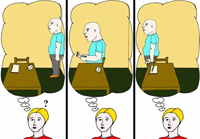Project description
The project group focuses on the structure and the functioning of a verbal category which has recently found considerable attention in first as well as in second language acquisition - finiteness. The distinction between finite and non-finite verb forms is familiar from the days of the Greek grammarians; but it has never found a proper definition. Traditionally, it is primarily seen as a morphological phenomenon: verb forms that are inflected for tense, mood, person, number and maybe other categories are considered to be finite, all others are considered as non-finite.
This view, however, is unsatisfactory for at least two reasons. First, the distinction between finite and non-finite forms is also made when there is hardly any morphological distinction on the verb. Thus, by far most English verb forms can be finite as well as non-finite. Second, there is a number of syntactic, semantic and pragmatic phenomena which are clearly associated with the presence or absence of finiteness. These include, for example, basic word order rules, the licensing of grammatical subjects and of expletive elements, constraints of gapping, non-specific readings of indefinite noun phrases in non-finite constructions, the temporal interpretation of verbal elements, the role of temporal adverbials, and the interaction with the negation not and other particles such as such as only or too. It appears, therefore, that finiteness is not a mere fact of verb morphology but a grammatical category in its own right.
The finiteness group studies the way in which the semantic concept of assertion is turned into a grammatical category which may then lead to further ramifications of the structure of a learner variety. Researchers in the group thereby focus on the following main topics:
The early expression of semantic finiteness
- how do early illocutive markers develop into abstract assertion markers?
- is illocutionary force expressed before tense/agreement?
- how source- or target-language dependent are certain initial orderings?
- which role does intonation play in early assertion marking?
- how do beginning learners (speakers of a Basic Variety) process and understand finite and non-finite constructions?
The acquisition of morpho-syntactic finiteness
- what exactly is the role of auxiliary verbs in the acquisition of auxiliary-languages like German and Dutch?
- do light verbs play a similar role in the acquisition of different target languages (e.g. Russian)?
- how does early
morpho-syntactic finiteness marking interact with negation and additive
scope particles?
The consequences of morpho-syntactic finiteness for the structure of a learner variety
- what are the effects on word order constraints (e.g. in so-called V2-languages)?
- how do languages with flexible word order compare to V2-languages in this respect?
- what are the consequences if finiteness markers can appear in different positions? (scope? illocution type? marking of topic/focus boundaries?)
- which other means can be used for those purposes in languages with severe word order constraints?
In order to cover the three comparative dimensions mentioned in the introduction, members of the finiteness group
- study finiteness L1 as opposed to L2 acquisition
- address the development of finiteness in L2 learners of different ages
- investigate the acquisition of finiteness in different languages
